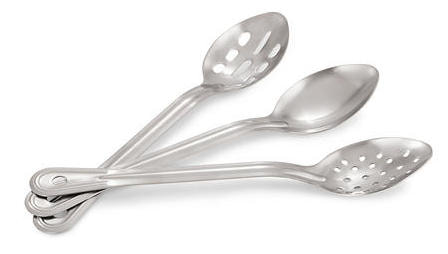|
Click and expand the tabs below to get started. What you need
Experimental procedure
What's Happening
If an object moves back and forth repeatedly we say that it is vibrating, and the number of times the object moves back and forth each second is called the frequency of the vibration, which is measured in Hertz (Hz). If it moves back and forth many times each second it has a high frequency, fewer times per second is a lower frequency. Lots of metal objects (like your spoon) will vibrate if you strike or tap them, but they don't just vibrate with any random frequency. Any object has a set of special frequencies at which it naturally prefers to vibrate, called its natural or resonant frequencies, which depend on the various dimensions of the object (size, shape, thickness, weight, etc.) as well as the material from which it is made. When you tap your spoon it vibrates, and as the spoon moves back and forth it collides with air molecules nearby, causing them to move. Those air molecules in turn collide with their neighboring air molecules, and so on, launching waves of molecules through the air- just like the waves of water molecules you launch when you move your hand back and forth in the bathtub. You may not be able to see the air waves, but you can feel them if you move your hand back and forth quickly near your face! You can also hear these waves (as long as the frequency of the waves is not too high or too low), so we call them sound waves. The frequency of a sound wave corresponds to the pitch or musical note, and our human ears can hear sound waves with frequencies between about 20 Hz (a very low note) and 20,000 Hz (or 20 kHz, a very high note). Of course you would need to move your hand pretty fast to actually hear those sound waves, but you can hear the sound waves traveling through the air when your spoon vibrates, because it's vibrating at a much higher frequency. [And spoons will vibrate at different natural frequencies depending on their size, shape and material- see the related activity below.] Of course we hear all of this because the sound waves travel through the air to your ears, where the vibrating air molecules collide with your ear drum and cause it to vibrate. This finally sends signals your brain which it interprets as sound from the spoon (see the link below to learn exactly how your ears work). Sound waves don't just travel through air (or other gasses), they can also travel through liquids and even solids in exactly the same way. Just as a vibrating object collides with nearby air molecules to make them vibrate (i.e. they're now moving back and forth), molecules and atoms in liquids and solids can be made to vibrate as well. When you tap the spoon it vibrates, but that also makes the string attached to it vibrate (just like a guitar string), and because the string is wrapped around your finger it vibrates too. If you put your finger in your ear that even makes your skull vibrate a little, which finally makes your eardrum vibrate and you finally hear the sound that came from the spoon again. The sound waves travelled through the string and through your body to your ears. But why does it sound so different this time? First we must understand that the spoon isn't vibrating with only one single frequency, but rather a series of related frequencies called the harmonic series, harmonics or sometimes the overtones, where each member in the series is a multiple of the fundamental or lowest frequency. For example, if the fundamental frequency (or 1st harmonic) is 500 Hz, then the second harmonic would be 1,000 Hz (2 x 500), the third harmonic 1,500 Hz (3 x 500), etc. When the spoon vibrates some of these frequencies are stronger (i.e. they move more) while others are weaker. The sound we hear from the spoon is really a simultaneous combination of the sound waves from each of these harmonic vibrations, the stronger ones are louder and the weaker ones are quieter (and some perhaps missing altogether). In music this is called timbre, and is the reason that musical instruments or singer's voices may sound very different even when they are playing (or singing) the exact same frequency or note. Finally, which harmonics we hear depends not only only those that are present to begin with, but also on which ones actually make it to our ears. In the first experiment when you tapped the spoon while you were just holding it, the sound waves you heard only travelled through the air to your ears. In the second experiment you plugged your ears with your fingers, so you couldn't hear most of the sound waves from the air, but you could hear the sound waves- or the vibrations- that travelled through your body, and those vibrations had very different frequencies which sounded deeper and richer, more like a gong or church bell rather than the ordinary spoon in air. Remember we said that objects prefer to vibrate at their own natural frequencies- the string and the bones in your body are very different from air molecules- so they vibrate very differently, and that affects which sound waves travel the best and which of the harmonic vibrations of the spoon will be louder or quieter once they reach your ears. Lower frequencies travel through the string and especially your body much better than higher ones, which is why the spoon sounds so much deeper and richer the second time. variations and related activities
Coming soon. Vibrating other objects, they sound different because they have different natural frequencies. Why does your voice sound different to you (but not others) on recordings? Why does your voice sound different when you breathe helium? References and links to more information
There's no sound in space:
Human ears and hearing:
Harmonics:
Why does your voice sound higher when you breathe helium?:
0 Comments
Your comment will be posted after it is approved.
Leave a Reply. |







